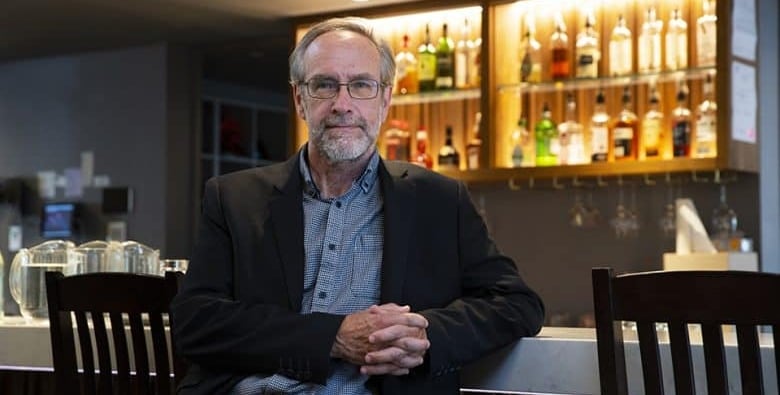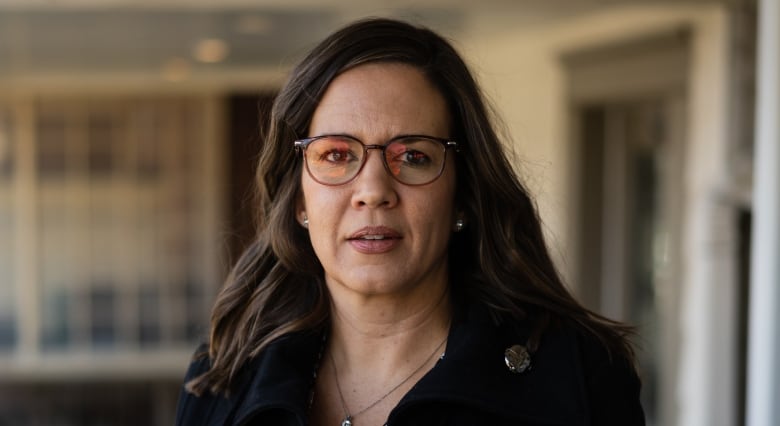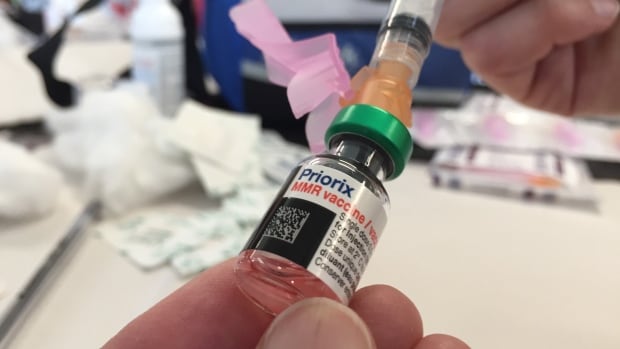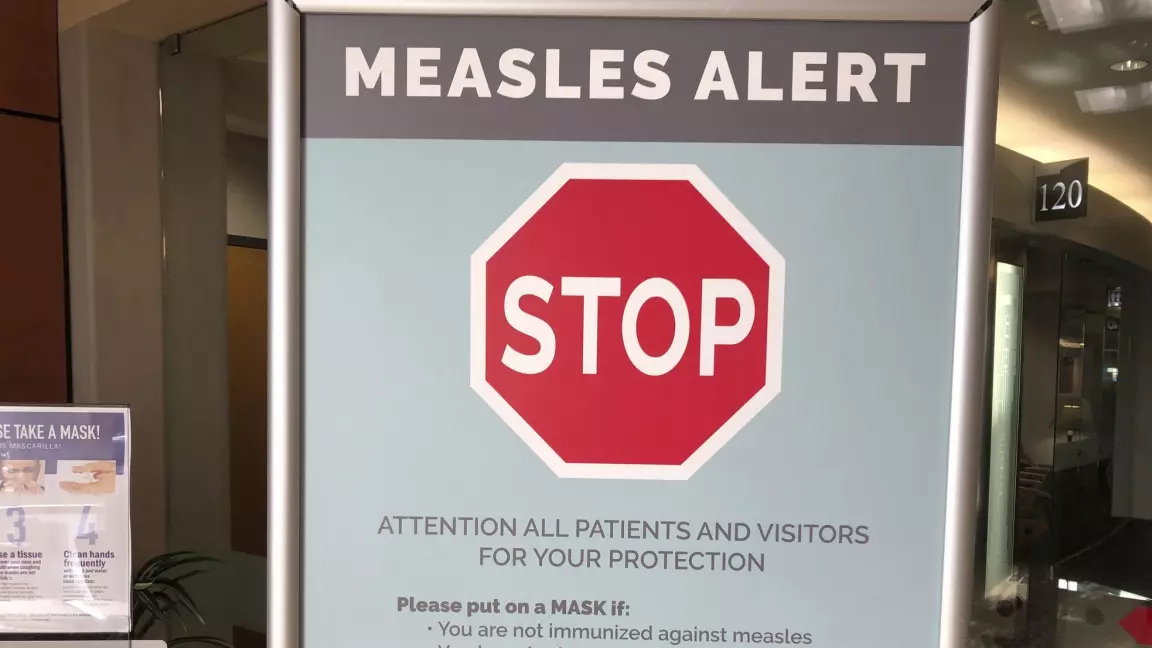Health
Alcohol is a top cause of preventable cancer and should have warning labels, doctors and researchers say – CBC News

It’s not a secret, but it may as well be. Few Canadians know the truth, and few may want to hear it: alcohol, any amount of alcohol, can cause cancer. There is no safe amount, and the calls to inform Canadians are growing.
“Even drinking one drink a day increases your risk of some cancers — including, if you’re a woman, breast cancer — but also cancers of the digestive system, the mouth, stomach,” said Tim Stockwell, a senior scientist with the Canadian Institute for Substance Use Research at the University of Victoria.
“The risk increases with every drink you take.”
Alcohol has been classified as a Group 1 carcinogen (carcinogenic to humans) for decades by the International Agency for Research on Cancer (IARC). It’s right up there with tobacco and asbestos. Alcohol is also a top cause of preventable cancer after smoking and obesity.
But the vast majority of Canadians have no idea of the risk.
Stockwell wants to change that, and he and other health experts are advocating for cancer warning labels on alcohol containers. People need to know, he says, that though there are other genetic and lifestyle factors that contribute to developing cancer, every drink comes with a risk.
“The risk from alcohol, it’s a dose response. The bigger and more frequent the dose, the higher your risk.”
Kathy Andrews had no idea that the wine she enjoyed most nights before she got pregnant was dangerous. The Vancouver resident was diagnosed with breast cancer in 2016.
“Some of the risk factors for me were that I’d been through IVF with my child and then pregnancy, as well as a stressful lifestyle and drinking, not exercising enough. So all of those things, I think, played a role,” she said.
When Andrews did her own research after her diagnosis, she says she was shocked to discover that moderate alcohol consumption has been linked to an approximate 30 to 50 per cent increased risk of breast cancer.
WATCH | Cancer survivor Kathy Andrews on why she’s dismayed at the lack of public awareness of alcohol’s link to cancer:
Vancouver resident Kathy Andrews, who was diagnosed with breast cancer in 2016, talks about why she’s dismayed that most people don’t know that alcohol can cause cancer. 0:17
Andrews is not alone.
According to the Canadian Institute for Substance Use Research, only about 25 per cent of Canadian drinkers know that alcohol can cause cancer.
In Canada, alcohol was linked to 7,000 new cancer cases in 2020 alone.
Soaring alcohol sales since the start of the pandemic have triggered concerns of an impending global increase in related cancer cases. Experts say the risk has always been there, but is easy to ignore because drinking is so normalized and so celebrated as a form of relaxation and reward.
“COVID will end, right, and cancer will continue, and there will be more cancer because people are drinking more,” said Dr. Fawaad Iqbal, a radiation oncologist at the Durham Regional Cancer Centre in Oshawa, Ont.
Iqbal says even among his cancer patients, the perception persists that consuming moderate amounts of alcohol has health benefits, particularly for cardiovascular health. Iqbal says studies suggesting health benefits have largely been debunked, yet they continue to circulate, adding to the general confusion and misunderstanding.
And he says that despite what those studies find, it doesn’t negate the fact alcohol can cause cancer and that people should be aware of that risk.
WATCH | Radiation oncologist Dr. Fawaad Iqbal on the links between alcohol and cancer:
Dr. Fawaad Iqbal, a radiation oncologist at the Durham Regional Cancer Centre in Oshawa, Ont., describes the lack of knowledge even among cancer patients that alcohol is a carcinogen. 0:13
“It’s shocking. In an information era, we have warning labels on everything I can think of. I bought my kids fishing rods this summer, and their fishing rods have warning labels that say this fishing rod can cause cancer. Whereas, you know, a level-one carcinogen that is everywhere has no particular warnings on it.”
Iqbal has drafted a proposal to the Canadian Medical Association asking it to advocate for explicit labelling of alcoholic beverages warning of the carcinogenic risk to the consumer. He’s also reached out to Ontario’s liquor board, provincial and federal health authorities, as well as to the prime minister.
“I don’t like when people are lied to, including myself. This toxin is there for everybody to consume and nobody’s warning you.”
As for why so many people are in the dark, Iqbal says he thinks that, “it boils down to money. Alcohol is a $1.5 trillion a year [global] industry. They’ll lose money, and money wins at the end of the day.”
Stockwell says the experience of the Yukon is proof of that.
In 2017, public health researchers and the Yukon government agreed to test cancer warning labels on all alcohol containers in the government-owned liquor store in Whitehorse. But less than a month after the cancer labels were put on, they were taken off under pressure from the alcohol industry.
Stockwell was one of the label study’s leaders. He says even though alcohol is a known carcinogen, industry representatives argued the cancer labels were alarmist and misleading. The territory, he says, couldn’t afford a potential costly legal battle, so the cancer warning labels were pulled while other labels, including information about standard drink size and low-risk drinking guidelines, remained.
“The industry’s claims of defamation were completely false, completely and utterly false,” Stockwell said. But, he added, “they serve the purpose of delaying, freezing things from happening, and in some ways, keeping that message out of the awareness.”


CBC’s The National reached out to Beer Canada, Spirits Canada and Wine Growers Canada asking whether they accept the link between alcohol and cancer, and whether they believe they have a responsibility to inform consumers of that risk. All three focused their answers on the need to drink responsibly and in moderation.
In a statement, Beer Canada said, “The decision whether to drink, and if so, how much, is a personal one. Responsible, moderate consumption can be part of a balanced lifestyle for most adults of legal drinking age.” It added that it is common knowledge that over-consumption comes with health risks and that, “For some people, even moderate consumption may be associated with health risks.”
Wine Growers Canada (WGC) said it is aware of the health risks that may be associated with alcohol consumption, and it recently launched the The Right Amount initiative, “to provide Canadians with information and tools to help make informed decisions on alcohol consumption.” It noted that the website includes responsible drinking guidelines, a standard drink calculator, and harm reduction recommendations for at-risk groups including pregnant women and youth.
It also added that, “the right amount of alcohol for some is none.”
As for Spirits Canada, it maintains there are health benefits to drinking. In a statement, it said, “moderate consumption of alcohol has long been recognized as contributing to a healthy lifestyle and research has consistently indicated beneficial effects for cardiovascular diseases, reducing the risk of stroke and some diseases associated with aging.”
Spirits Canada added there are several policies in place to ensure consumers are aware of the risks of misusing alcohol, including government-controlled liquor boards, legal drinking age requirements, as well as restrictions on where alcohol can be sold and the setting of minimum prices. “Against this comprehensive background of control and management of alcohol, warning labels have not been shown to be useful in altering consumer behaviour or reducing the amount people drink.”
However, evidence of the effectiveness of alcohol labels is growing, including the results of the Yukon labelling study. It continues to be cited by researchers and governments around the world because, despite the alcohol industry’s intervention, the study found information had an impact on people’s behaviour.
Stockwell says even though the cancer labels were only in place for four weeks during the study, people remembered them. Combined with the other labels that remained on alcohol containers for a total of four months, researchers found that by the end of the study alcohol sales dropped by about 7 per cent.
Another key finding, says Stockwell, is that the more people knew, the angrier they got.
WATCH | Tim Stockwell on alcohol ‘masquerading as something safe and glamourous’:
Tim Stockwell, a senior scientist with the Canadian Institute for Substance Use Research at the University of Victoria, says that in a study of alcohol warning labels in Yukon, people were ‘furious’ when they were told about the cancer risks associated with drinking alcohol. 0:12
Dr. Erin Hobin co-led the study with Stockwell. A senior scientist at Public Health Ontario as well as a collaborating scientist with the Canadian Institute for Substance Use Research, Hobin says the study’s labels were effective because they were well-designed. They were intentionally colourful and used a bold font, which helped make the message clear to consumers.
Hobin says the Yukon study also found that the more aware people were about the risks related with alcohol, the more likely they were to support increases in its price.
“Which generally is not a popular policy among the public or policy makers, but is a policy that is well-established for reducing alcohol harm,” Hobin said.
Hobin adds that Canada is a world leader in designing effective tobacco and cannabis warning labels. She says recent research indicates that labels that are well-designed, “can be an effective tool for supporting more informed and safer decisions related to alcohol, and may even start to shift consumers perceptions of alcohol from a relatively benign substance to a substance associated with serious health risks that should be considered when drinking alcohol.”


Several European countries are considering cancer warning labels on alcohol.
Asked by CBC’s, The National whether Health Canada plans to do the same, a department spokesperson says it continues to fund research into the best ways to inform Canadians of the various harms associated with alcohol use, and that updates to the current national low-risk drinking guidelines and standard drink information are coming. Those updates are expected at the end of this year.
In the meantime, awareness is spreading through graphic public health campaigns around the world, including in the U.S. and Australia. Just before the pandemic, British Columbia’s Fraser Health Authority also ran posters spelling out the cancer risks that come with drinking.
Health professionals are urging governments at every level to act now to warn Canadians about the cancer risk as well as other alcohol-related diseases.
“I think it’s tragic,” said Dr. Eric Yoshida, a professor of medicine at the University of British Columbia and chair of the Canadian Liver Foundation’s Medical Advisory Committee. “I think it’s actually horrible. I think it’s unacceptable. I think the conversation should have started years ago, decades ago.”
Yoshida is calling for product warning labels to raise awareness and deter alcohol misuse. He says he has seen a “tidal wave” of patients in need of a transplant since 2019, when patients in B.C could qualify for a liver transplant without needing to abstain from drinking for six months.
Many of his patients, Yoshida says, are young people in their 20s and 30s who had no idea their drinking could cause so much harm.
“They were shocked,”‘ he said, to realize, “that the alcohol could actually kill them.”
WATCH | Dr. Eric Yoshida on the devastating impact of alcohol and liver disease among young people:
Dr. Eric Yoshida, a professor of medicine at the University of British Columbia and chair of the Canadian Liver Foundation’s Medical Advisory Committee, says patients – particularly younger ones – often express shock and disbelief that alcohol has caused them serious illness. 0:34
Yoshida says warning labels must be part of a broader awareness effort.
“I think the government has to step up. I think leaving it to the education system, leaving it to the media, leaving it to people’s families, I think it probably isn’t good enough.”
Breast-cancer survivor Andrews agrees, adding that had she known of the cancer risks linked to drinking, she would have abstained or consumed a lot less. She’s grateful that she’s now recovering, but wants people to know more than she did.
“It can cut their lives short and take them away from the people that love them. People are putting really dangerous stuff in their bodies, and they don’t know. And it’s not worth it.”
Watch full episodes of The National on CBC Gem, the CBC’s streaming service.
Health
Quebec successfully pushes back against rise in measles cases – CBC.ca


Quebec appears to be winning its battle against the rising tide of measles after 45 cases were confirmed province-wide this year.
“We’ve had no locally transmitted measles cases since March 25, so that’s good news,” said Dr. Paul Le Guerrier, responsible for immunization for Montreal Public Health.
There are 17 patients with measles in Quebec currently, and the most recent case is somebody who was infected while abroad, he said.
But it was no small task to get to this point.
Le Guerrier said once local transmission was detected, news was spread fast among health centres to ensure proper protocols were followed — such as not letting potentially infected people sit in waiting rooms for hours on end.
Then about 90 staffers were put to work, tracking down those who were in contact with positive cases and are not properly vaccinated. They were given post-exposure prophylaxis, which prevents disease, said Le Guerrier.
From there, a vaccination campaign was launched, especially in daycares, schools and neighbourhoods with low inoculation rates. There was an effort to convince parents to get their children vaccinated.
Vaccination in schools boosted
Some schools, mostly in Montreal, had vaccination rates as low as 30 or 40 per cent.
“Vaccination was well accepted and parents responded well,” said Le Guerrier. “Some schools went from very low to as high as 85 to 90 per cent vaccination coverage.”
But it’s not only children who aren’t properly vaccinated. Le Guerrier said people need two doses after age one to be fully inoculated, and he encouraged people to check their status.
There are all kinds of reasons why people aren’t vaccinated, but it’s only about five per cent who are against immunization, he said. So far, some 10,000 people have been vaccinated against measles province-wide during this campaign, Le Guerrier said.
The next step is to continue pushing for further vaccination, but he said, small outbreaks are likely in the future as measles is spreading abroad and travellers are likely to bring it back with them.
Need to improve vaccination rate, expert says
Dr. Donald Vinh, an infectious diseases specialist from the McGill University Health Centre, said it’s not time to rest on our laurels, but this is a good indication that public health is able to take action quickly and that people are willing to listen to health recommendations.
“We are not seeing new cases or at least the new cases are not exceeding the number of cases that we can handle,” said Vinh.
“So these are all reassuring signs, but I don’t think it’s a sign that we need to become complacent.”
Vinh said there are also signs that the public is lagging in vaccine coverage and it’s important to respond to this with improved education and access. Otherwise, microbes capitalize on our weaknesses, he said.
Getting vaccination coverage up to an adequate level is necessary, Vinh said, or more small outbreaks like this will continue to happen.
“And it’s very possible that we may not be able to get one under control if we don’t react quickly enough,” he said.
Health
Pregnant women in the Black Country urged to get whooping cough vaccine – BBC.com


Pregnant women urged to get whooping cough vaccine
Pregnant women in the Black Country are being urged to get vaccinated against whooping cough after a rise in cases.
The bacterial infection of the lungs spreads very easily and can cause serious problems, especially in babies and young children.
The Black Country Integrated Care Board (ICB) is advising pregnant women between 16 and 32 weeks to contact their GP to get the vaccine so their baby has protection from birth.
The UK Health Security Agency warned earlier this year of a steady decline in uptake of the vaccine in pregnant women and children.
Symptoms of the infection, also known as “100-day cough”, are similar to a cold, with a runny nose and sore throat.
Sally Roberts, chief nursing officer for the ICB, which covers Wolverhampton, Dudley, Walsall and Sandwell, said anyone could catch it, but it was more serious for young children and babies.
“Getting vaccinated while you’re pregnant is highly effective in protecting your baby from developing whooping cough in the first few weeks of their life – ideally from 16 weeks up to 32 weeks of pregnancy,” she said.
“If for any reason you miss having the vaccine, you can still have it up until you go into labour.”
Follow BBC West Midlands on Facebook, X and Instagram. Send your story ideas to: newsonline.westmidlands@bbc.co.uk
Health
Measles cases stabilize in Montreal – CityNews Montreal


The number of measles cases has stabilized, according to the Montreal Public Health.
Since March 25, there have been no contaminations reported within the community.
“Our teams have identified all contact cases of measles,” said media relations advisor Geneviève Paradis. “It’s a laborious task: each measles case produces hundreds of contacts.”
All community transmission cases since February 2024 have been caused by returning travelers who were either unvaccinated or partially vaccinated.
Currently, there are 18 measles cases in Montreal – with 46 total in Quebec. This according to the April 18 figures from the provincial government.
“With the summer vacations approaching, if you’re travelling, it is essential to check if you are protected against measles,” explained Paradis.
According to Montreal Public Health, a person needs to have received two doses after the age of 12 months to be immunized against the virus.
They’ve launched a vaccination campaign throughout the region, and currently, 11,341 people have been vaccinated against measles in Montreal between March 19 and April 15.
Vaccination is also being provided in schools and at local service points.
“The vaccination operation is under the responsibility of the five CIUSSS of the territory,” concluded Paradis.
-



 Tech20 hours ago
Tech20 hours agoCytiva Showcases Single-Use Mixing System at INTERPHEX 2024 – BioPharm International
-
News22 hours ago
Tim Hortons says 'technical errors' falsely told people they won $55K boat in Roll Up To Win promo – CBC.ca
-



 Health16 hours ago
Health16 hours agoSupervised consumption sites urgently needed, says study – Sudbury.com
-



 Tech22 hours ago
Tech22 hours agoAaron Sluchinski adds Kyle Doering to lineup for next season – Sportsnet.ca
-



 Politics23 hours ago
Politics23 hours agoTrump faces political risks as trial begins – NBC News
-
News15 hours ago
2024 federal budget's key takeaways: Housing and carbon rebates, students and sin taxes – CBC News
-
Tech21 hours ago
Nintendo Indie World Showcase April 2024 – Every Announcement, Game Reveal & Trailer – Nintendo Life
-
News16 hours ago
Canada's 2024 budget announces 'halal mortgages'. Here's what to know – National Post









